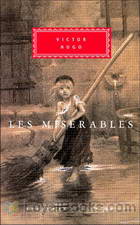|
Books Should Be Free Loyal Books Free Public Domain Audiobooks & eBook Downloads |
|
|
Books Should Be Free Loyal Books Free Public Domain Audiobooks & eBook Downloads |
|
Author Collection |
|---|
By: Victor Hugo (1802-1885) | |
|---|---|
 Les Misérables
Les Misérables
Victor Hugo's Les Misérables is a novel which tells the story of ex-convict Jean Valjean, his struggles and eventual redemption. It's hailed by many critics as not just Victor Hugo's finest work but also one of the best French novels of all time. Like most epic novels written in the 19th century, the storyline of Les Misérables spans through several decades beginning in the early 1800s and culminating in the 1832 June Rebellion in Paris. The events related to the lives of the central characters in the novel are also tied to the great historical events of the time from the French Revolution to the June Rebellion... | |
 Les Misérables, Volume 3
Les Misérables, Volume 3
This is volume 3 of 5. – An ex-convict breaks parole and starts a new life as a righteous man, but is pursued by a police inspector. Along the way, the ex-convict joins a revolution, adopts a daughter, and beats people up. Hooray. | |
 (French) Les Misérables
(French) Les Misérables
C’est un roman historique, social et philosophique dans lequel on retrouve les idéaux du romantisme et ceux de Victor Hugo concernant la nature humaine. L’auteur lui-même accorde une grande importance à ce roman et écrit en mars 1862, à son éditeur Lacroix : « Ma conviction est que ce livre sera un des principaux sommets, sinon le principal, de mon œuvre ». Le tome I de l’œuvre qui en compte cinq est consacré à Fantine. (Source : Wikipedia) | |
 The Hunchback of Notre Dame
The Hunchback of Notre Dame
One of the great literary tragedies of all time, The Hunchback of Notre Dame features some of the most well-known characters in all of fiction - Quasimodo, the hideously deformed bellringer of Notre-Dame de Paris, his master the evil priest Claude Frollo, and Esmeralda, the beautiful gypsy condemned for a crime she did not commit. | |
 (French) Les Misérables, tome 2
(French) Les Misérables, tome 2
C'est un roman historique, social et philosophique dans lequel on retrouve les idéaux du romantisme et ceux de Victor Hugo concernant la nature humaine. L'auteur lui-même accorde une grande importance à ce roman et écrit en mars 1862, à son éditeur Lacroix : « Ma conviction est que ce livre sera un des principaux sommets, sinon le principal, de mon œuvre ». Le tome II de l'œuvre qui en compte cinq est consacré à Cosette. (Source : Wikipedia) | |